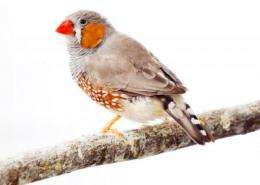MicroRNAs in the songbird brain respond to new songs (w/ video)

Whenever it hears an unfamiliar song from a bird of the same species, a zebra finch stops chirping, hopping and grooming. It listens attentively for minutes at a time, occasionally cocking its head but otherwise immobile. Once it becomes familiar with the song, it goes back to its busy routine.
In a new study, researchers discovered that levels of microRNAs – short lengths of ribonucleic acid that appear to regulate protein production – go up or down in the songbird brain after it hears a new song. These microRNAs likely represent a new class of regulatory agents that fine-tune the brain's response to social information, said University of Illinois cell and developmental biology professor David Clayton, who led the study.
MicroRNAs are part of a new frontier in genomic biology: the 90 percent of human DNA that doesn't code for proteins. This "dark matter of the genome" includes genes that are transcribed into many different types of RNA molecules. Scientists are still working to decipher their various structures and functions.
Previous studies found that brain microRNAs "undergo dramatic changes in expression during development and aging and have been functionally implicated in neurological disease," the authors wrote in their paper in BMC Genomics. MicroRNAs appear to regulate the expression of protein-coding genes by binding to messenger RNA (mRNA) transcripts, the blueprints for proteins, before they can be translated into proteins.
Clayton and other researchers have documented changes in the expression of many mRNAs in the songbird brain after it hears an unfamiliar song. But no studies have, until now, found evidence that microRNAs also contribute to the process by which the brain responds to its environment.
"The question that we started with was, are there microRNAs that are showing a response to song in the brain?" Clayton said. "And the answer is clearly yes, there are. The bigger question that we don't have an answer to yet is what are they doing?"
The study team, which included researchers from the Baylor College of Medicine and the University of Houston, also identified a microRNA that went up in males and down in females after the birds heard a new song. The gene for this microRNA is on the Z chromosome, the zebra finch's sex chromosome. Male zebra finches have two copies of the gene and females have only one, suggesting that even baseline levels of this microRNA differ between the sexes.
"To my knowledge, this is the first example of a gene response that's different in male and female songbirds," said Clayton, who also is an affiliate of the Institute of Genomic Biology and the Beckman Institute, both at Illinois.
Since microRNAs can interfere with the translation of mRNAs into protein, Clayton hypothesizes that mRNAs play a part in fine-tuning the brain's response to important signals.
"We do see a sudden disappearance of some types of messenger RNA shortly after a bird hears a song," he said. "We don't yet know the mechanism of that, but that's something a microRNA could be doing."
More information: The paper, "Song Exposure Regulates Known and Novel MicroRNAs in the Zebra Finch Auditory Forebrain," is available online.
Provided by University of Illinois at Urbana-Champaign












